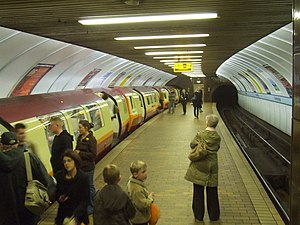
Summary
Kelvinbridge subway station is a Glasgow Subway station serving the Woodlands, Woodside and Hillhead areas of Glasgow, Scotland. It is named after the bridge crossing the River Kelvin, next to the station. This station is one of the two serving Kelvingrove Park, the other being Kelvinhall.
Kelvinbridge | |||||||||||
|---|---|---|---|---|---|---|---|---|---|---|---|
| Scottish Gaelic: Drochaid Cheilbhinn[1] | |||||||||||
 | |||||||||||
| General information | |||||||||||
| Location | 99 South Woodside Road Kelvinbridge, Glasgow, G4 9HG[2] Scotland | ||||||||||
| Coordinates | 55°52′27″N 4°16′50″W / 55.87417°N 4.28056°W | ||||||||||
| Operated by | SPT | ||||||||||
| Platforms | 2 (island platform) | ||||||||||
| Tracks | 2 | ||||||||||
| Construction | |||||||||||
| Structure type | Underground | ||||||||||
| Parking | Yes[2] | ||||||||||
| Bicycle facilities | Yes (bike shed and bike hire)[3] | ||||||||||
| Accessible | No[4] | ||||||||||
| History | |||||||||||
| Opened | 14 December 1896 | ||||||||||
| Rebuilt | 16 April 1980 | ||||||||||
| Passengers | |||||||||||
| 2018 | |||||||||||
| 2019 | |||||||||||
| 2020 | |||||||||||
| 2021 | |||||||||||
| 2022 | |||||||||||
| Services | |||||||||||
| |||||||||||
| Location | |||||||||||
 | |||||||||||
| Notes | |||||||||||
Passenger statistics provided are gate entries only. Information on gate exits for patronage is incomplete, and thus not included.[8] | |||||||||||
The station – along with the rest of the Subway system – was opened in 1896 and closed for refurbishment in 1977, reopening in 1980. It retains the original island platform layout, and is by far the busiest station to retain this configuration.
The station has a car park, built on the site of the goods yard at Kelvinbridge on the Stobcross to Maryhill Central line.
The station is the deepest station on the Subway due to its close proximity to the River Kelvin - and as such the tunnels are prone to seepage in this area, necessitating pumping systems which run continuously to keep the station dry. It was originally entered through a tenement block on South Woodside Road with access to Great Western Road via an external cast iron staircase descending from the eponymous bridge. Following modernisation, a purpose-built surface-level ticket hall has offered direct access to the new main entrance on Great Western Road via a glass-enclosed escalator.
The former station entrance is now the emergency exit from today's station, the emergency exit being marked by grey doors at the bottom of the iron staircase, and "keep clear" signs.
Past passenger numbers edit
- 2011/12: 0.913 million annually[9]
References edit
- ^ King, Jake (12 July 2020). "Glasgow's Gaelic Underground". Ainmean-Àite na h-Alba. Archived from the original on 4 October 2022. Retrieved 17 February 2023.
- ^ a b "Maps & stations". spt.co.uk. Strathclyde Partnership for Transport. Archived from the original on 15 January 2023. Retrieved 16 February 2023.
- ^ "Bike parking facilities". spt.co.uk. Strathclyde Partnership for Transport. Archived from the original on 7 November 2022. Retrieved 16 February 2023.
- ^ "Accessibility & mobility". spt.co.uk. Strathclyde Partnership for Transport. Archived from the original on 7 November 2022. Retrieved 16 February 2023.
- ^ "Request for some usage statistics". Strathclyde Partnership for Transport. 11 January 2019. Archived from the original on 1 March 2019. Retrieved 28 February 2019 – via WhatDoTheyKnow.
- ^ a b c "Station usage statistics" (PDF). Strathclyde Partnership for Transport. 20 July 2022. Archived (PDF) from the original on 16 February 2023. Retrieved 16 February 2023 – via WhatDoTheyKnow.
- ^ "Request for annual Subway station patronage 2022". 22 February 2023. Archived (PDF) from the original on 22 February 2023. Retrieved 22 February 2023.
- ^ "Freedom of Information Request: Subway Station Usage Statistics" (PDF). Strathclyde Partnership for Transport. 3 August 2022. Archived (PDF) from the original on 17 February 2023. Retrieved 17 February 2023 – via WhatDoTheyKnow.
- ^ "Freedom of Information request: Subway station patronage - 1 April 2011 to 31 March 2012". Strathclyde Partnership for Transport. 18 December 2012. Archived from the original on 9 February 2019. Retrieved 9 February 2019 – via WhatDoTheyKnow.


